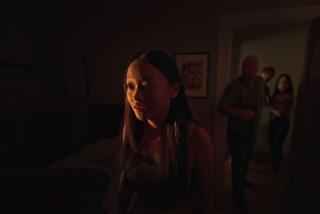BOOK REVIEW : Summer Tale of Ghostbusting, Parapsychology
- Share via
Julian’s House by Judith Hawkes (Ticknor & Fields: $18.95; 345 pp.)
Ghostbusters for grown-ups, “Julian’s House” is crammed with information about parapsychology. The agreeable young couple who rent the haunted Gilfoy house in the pleasant Massachusetts town of Skipton both have advanced degrees in the field, and plan to write a definitive paper on their summer adventures.
Though the Gilfoy house is fully furnished with a spirit presence that manifests itself in multiple ways, the Curtisses must supply the modern conveniences of their profession. All they get with the lease is a history of a bobbing light, a freezing draft in the master bedroom, an assortment of knocks and thumps, the howling of an invisible dog and an unconfirmed report of a green face at an attic window. To capture these elusive phenomena in action, they’ve borrowed the most advanced and sophisticated tools of their trade: cameras triggered by disturbances in the air; buzzers activated by subtle gradations in sound, light, heat and cold; tape recorders sensitive to noise unheard by human ears, and capacitance meters, which measure changes in the electromagnetic field. In addition to this carload full of state-of-the-art paraphernalia, David and Sally Curtiss have also brought along some marital problems, which they hope will be resolved by a summer of working together in this idyllic setting.
They begin their research by sending out questionnaires to all previous tenants of the house, and are gratified by prompt replies corroborating the disturbances. The few refusals only convince them that things too terrible to recall have indeed happened on the Gilfoy premises. Still, the first few weeks of their own tenancy are remarkably and disappointingly tranquil. Except for the faint scent of a non-existent wood fire, the house seems the ideal summer rental. To jazz things up, the Curtisses invite a highly recommended medium from Boston to visit, hoping that her presence will lure the spirit out of hiding.
A charming and attractive black woman, a set designer by profession, Rosanna manages to elicit some action from the hitherto reluctant ghost, as well as rousing David’s dormant sexuality. Unfortunately for the pace of the story, Rosanna is recalled to Boston; the empty space filled by extraordinarily detailed descriptions of the methodology of psychic research. The author has obviously done her homework, and though she carefully avoids committing herself to a belief in the supernatural, the reader is encouraged, if not urged, to open his mind and let the occult in, as some extremely eminent people always have.
Matters perk up somewhat when Sally meets the delightful town librarian and amateur historian, Colin, an elderly gentleman who has lived in Skipton all his life and can lead them to sources who might otherwise not volunteer to be interviewed. Once Colin joins the team, the Curtisses start to make headway. He finds old newspaper sources recording dark days in the Gilfoy manse; diaries with cryptic references to the personality of the Rev. Joshua Gilfoy, and gradually, a picture of an anguished 19th-Century family emerges; providing enough tumult to permeate the material of the house and cause the ruckus perceived by the tenants.
All you need do is persuade yourself that inanimate objects absorb the history of their owners, which is one of the prime hypotheses of parapsychology. Sensitive people (Hawkes is chary of the word medium ) can pick up these, well, “vibrations,” when conditions are propitious. Sally Curtiss is just such a sensitive person, though she’s unwilling to accept either the label or its implications. In fact, David was first attracted to her because she performed so brilliantly on telepathic tests, but who wants to be loved for her Rhine scores alone?
Towards the end of the book, when the experiment seems doomed by her reluctance to participate actively, Sally reluctantly agrees to serve as medium, and matters magically fall into place. To placate those who may have had trouble suspending their disbelief, the author supplies a scientifically plausible explanation for all events, but it’s plain that her heart isn’t in it.
Shifting between lyrical, didactic and conversational tones, the novel seems to reflect the accepted definition of a medium as someone with unresolved multiple personalities. Sally, David, and Colin try valiantly, but “Julian’s House” could use a character like the “Stay-Puff Marshmallow Man” to keep the story buoyant.
More to Read
The biggest entertainment stories
Get our big stories about Hollywood, film, television, music, arts, culture and more right in your inbox as soon as they publish.
You may occasionally receive promotional content from the Los Angeles Times.










